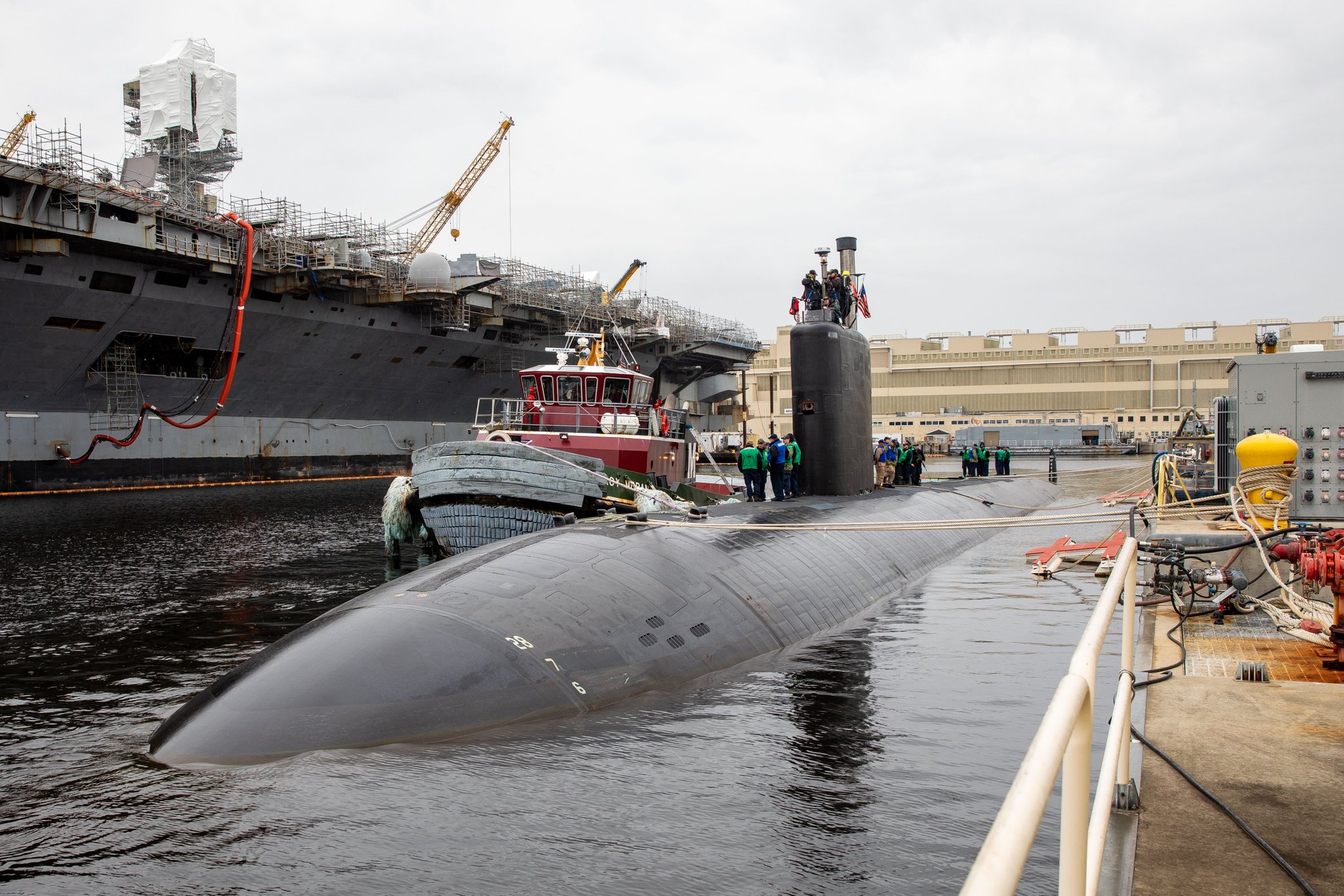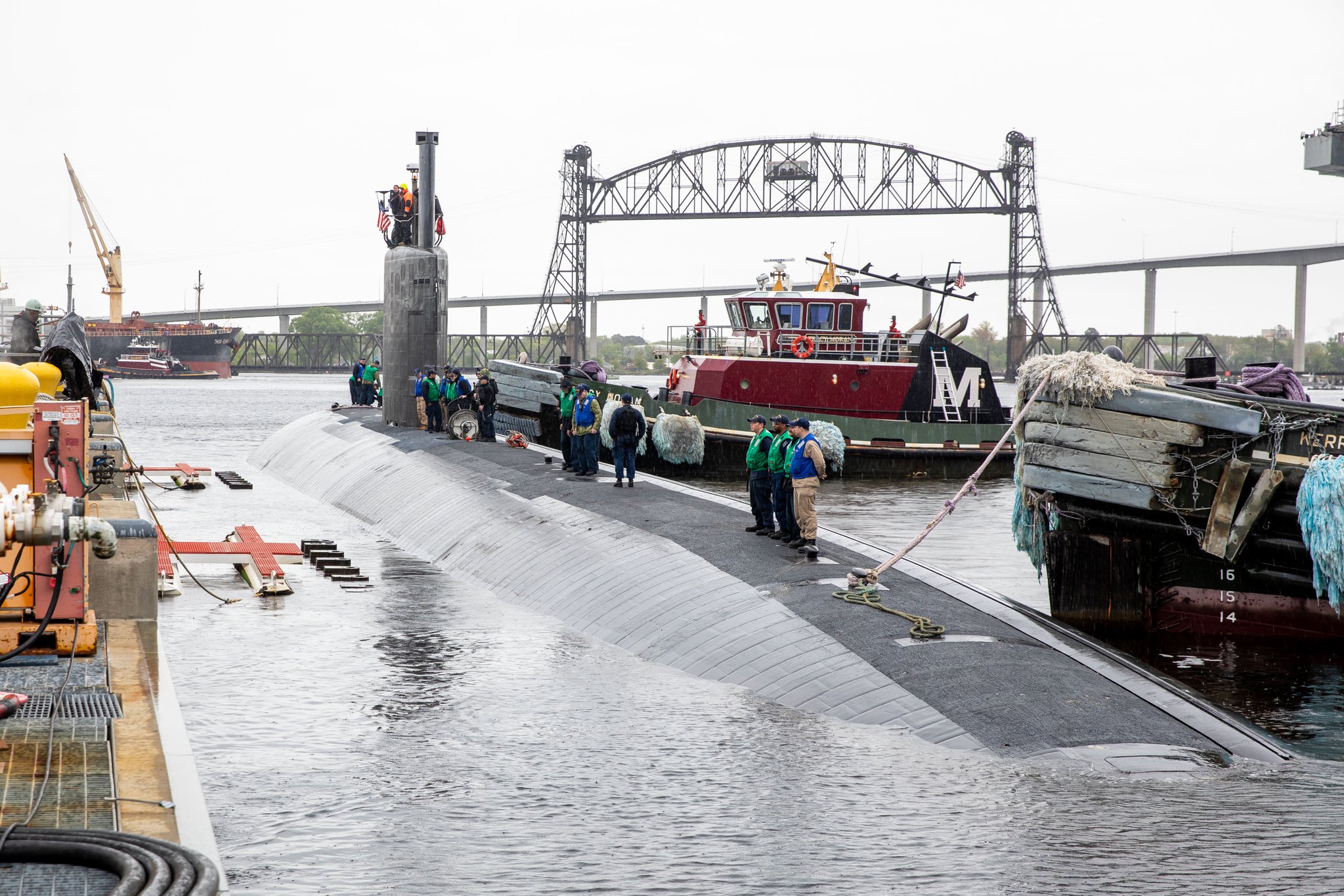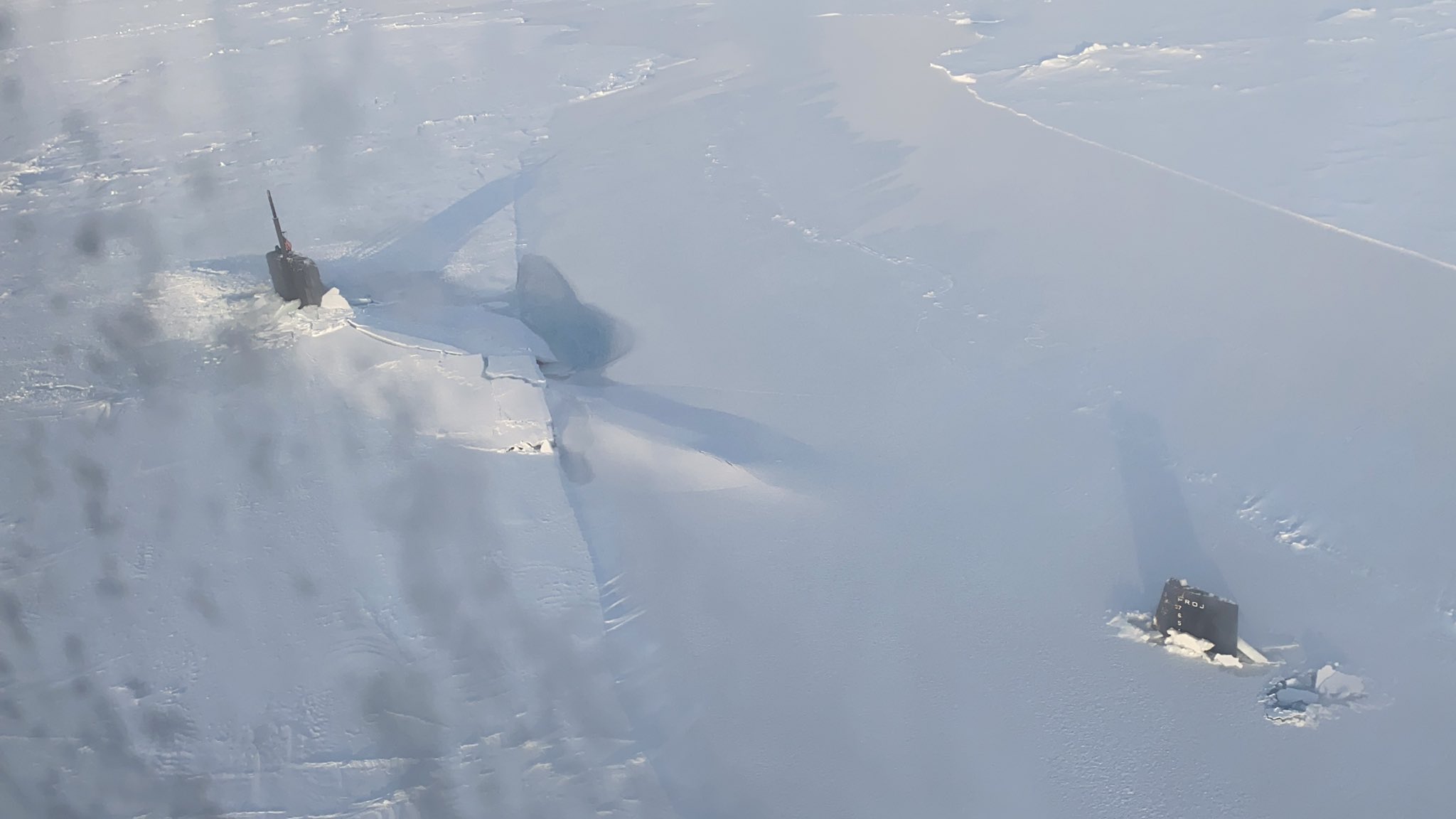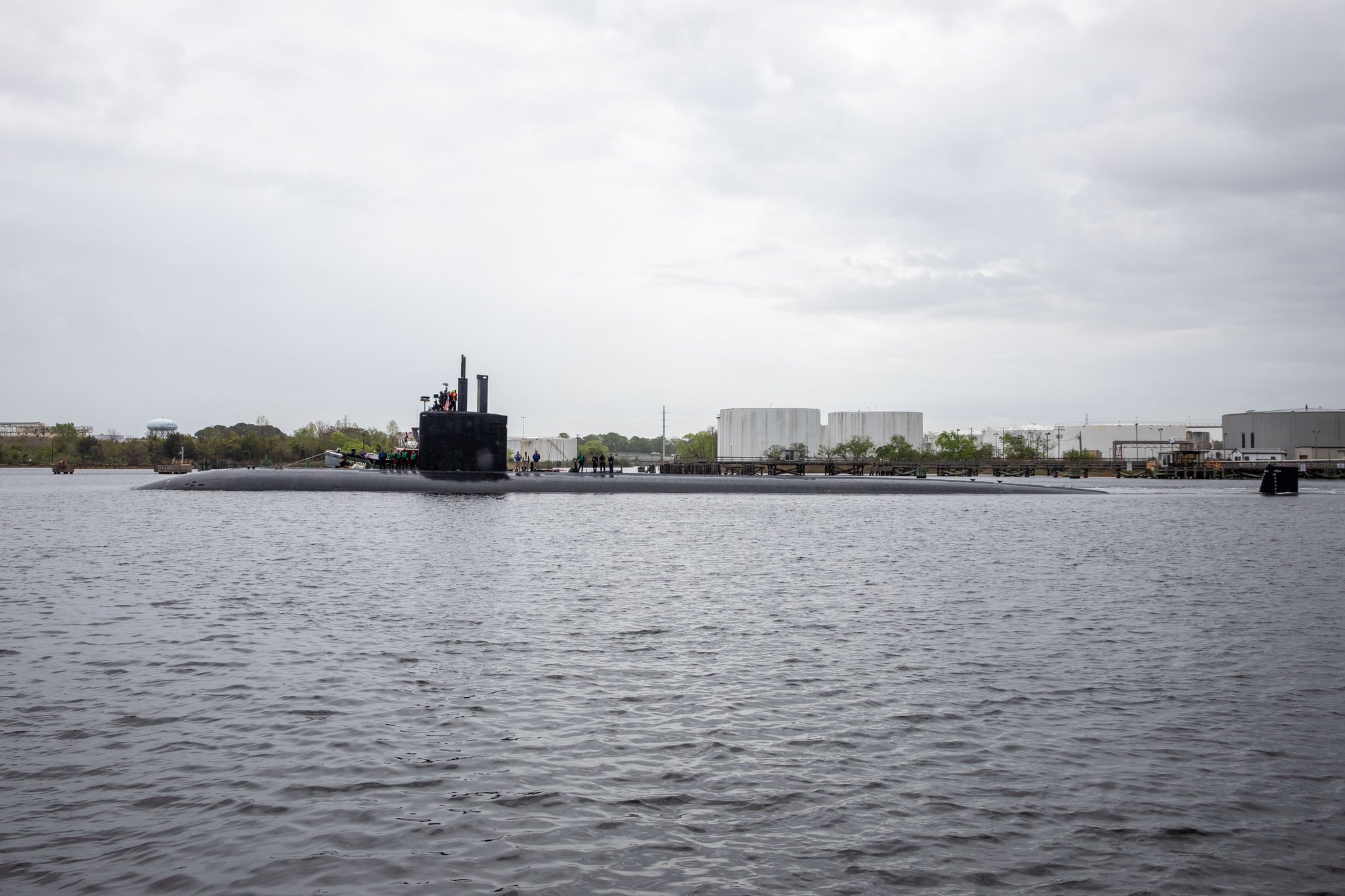Silent Giant Returns: USS Toledo Rejoins the Fleet After Epic Overhaul to Counter Rising Undersea Threats
More than just a technical milestone, the Toledo’s return to service affirms the broader strategic imperative of preserving the combat edge of the U.S. submarine force—one of the most potent components of American maritime power projection and deterrence.
(DEFENCE SECURITY ASIA) — The nuclear-powered USS Toledo (SSN 769), one of the United States Navy’s most capable fast-attack submarines, has officially returned to operational status following a protracted and complex Engineered Overhaul (EOH) at Norfolk Naval Shipyard, underscoring America’s commitment to sustaining undersea superiority in a rapidly evolving security landscape.
The extensive maintenance and modernization process, spanning years and millions of man-hours, was critical not only in extending the vessel’s service life but also in preparing it for the intensifying geopolitical contest for dominance beneath the world’s oceans.
More than just a technical milestone, the Toledo’s return to service affirms the broader strategic imperative of preserving the combat edge of the U.S. submarine force—one of the most potent components of American maritime power projection and deterrence.
The EOH, involving deep-level refits to structural and system-level components, necessitated drydocking the submarine for a full-spectrum overhaul aimed at enhancing survivability, stealth, and lethality across its mission set.
“An overhaul like this is a marathon, and I deeply appreciate the outstanding dedication shown by the project team, ship’s crew, and industry partners who pushed us all the way to the finish line,” said Captain Jip Mosman, Norfolk Shipyard Commander, in an official statement through DVIDS.
Originally charted as a two-year endeavor with an estimated workload of 3.5 million man-hours, the overhaul eventually extended beyond four years—reflecting the scale, sophistication, and unforeseen challenges of sustaining an aging yet strategically critical warfighting platform.
Toledo arrived at Norfolk Naval Shipyard on January 21, 2021, but was unable to enter drydock until May 1, 2021, due to ongoing repairs at the facility, a delay that forced significant rescheduling of critical maintenance operations.

These delays cascaded across the overhaul timeline, testing logistical agility and industrial readiness, and highlighted the strain placed on America’s submarine sustainment infrastructure amid rising demand for forward-deployed undersea capabilities.
After enduring one of the Navy’s most intensive submarine modernization efforts in recent memory, the USS Toledo was officially declared operational on April 19, 2025—returning to the fleet with upgraded systems, renewed structural integrity, and extended service viability.
Beyond standard repairs, the overhaul integrated state-of-the-art combat systems, advanced electronics, next-generation sensors, and platform survivability enhancements to ensure operational relevance in high-threat and denied-access maritime environments.
As part of this modernization process, the crew received refresher training on newly installed systems to ensure full mission-readiness under operational stress conditions.
The return of the Toledo to the fleet marks a decisive step in maintaining the combat readiness of the U.S. Navy’s Improved Los Angeles-class submarines, particularly as Russia and China continue expanding their naval footprints across contested theatres like the Arctic, South China Sea, and North Atlantic.
Commissioned on February 24, 1995, USS Toledo was purpose-built for multi-mission roles across the undersea battlespace, including anti-submarine warfare, anti-surface strikes, land-attack missions, covert intelligence gathering, and special operations support.
As a member of the Improved Los Angeles-class (688i), Toledo boasts enhanced acoustic stealth, upgraded sonar and combat systems, and Arctic-capable diving planes—distinguishing it significantly from earlier 688 variants and making it ideal for under-ice operations.

When surfaced, the submarine displaces around 6,200 tons, increasing to approximately 6,900 tons when submerged, a testament to the class’s robust construction and payload capacity.
Measuring 360 feet in length with a beam of 33 feet and a draft of 32.3 feet, Toledo is powered by a single S6G nuclear reactor that generates steam for two geared turbines, driving a single shaft and propulsor with an estimated 35,000 shaft horsepower.
While its top submerged speed remains classified, the vessel is believed to be capable of flank speeds exceeding 30 knots—providing rapid maneuverability across expansive maritime theatres.
Its nuclear propulsion grants it virtually unlimited range, enabling the submarine to remain submerged for up to 90 days, with operational limits dictated only by crew endurance and onboard provisioning.
With a certified test depth beyond 800 feet—and an actual maximum depth likely exceeding 1,000 feet—Toledo can operate in deep-ocean environments inaccessible to most adversarial navies, significantly enhancing survivability and mission flexibility.
The submarine is manned by a highly trained complement of 147 personnel, including 18 officers and 129 enlisted sailors, forming a tightly integrated warfighting unit capable of executing high-intensity undersea operations.
Toledo is equipped with four bow-mounted 21-inch torpedo tubes, enabling it to launch Mk-48 ADCAP torpedoes for both anti-submarine and anti-surface warfare with lethal precision.

The platform may also be configured to fire UGM-84 Harpoon anti-ship missiles and BGM-109 Tomahawk cruise missiles, providing standoff land-attack capability from both torpedo tubes and, in some variants, 12 vertical launch system (VLS) cells.
Its total weapons capacity ranges from 26 to 30 warloads—including torpedoes, missiles, and sea mines—offering extensive mission tailoring for conventional deterrence and area-denial roles.
Sensor systems include the AN/BQQ-5 or AN/BQQ-10 sonar suite, with active/passive arrays, AN/BQR-19 for high-frequency navigation and surfacing, and a towed array sonar for long-range submarine detection.
The AN/BSY-1 integrated sonar and combat system enhances fire control precision, while the AN/WLR-8 radar warning receiver and acoustic decoy systems bolster survivability in contested electromagnetic environments.
Toledo navigates using an inertial guidance system supplemented by GPS while surfaced and employs traditional periscopes alongside photonic masts for stealth visual surveillance.
Engineered with retractable bow planes for under-ice maneuvering, the submarine is also equipped to carry Dry Deck Shelters, enabling clandestine deployment of SEAL teams or unmanned undersea vehicles (UUVs).
Its anechoic coating and machinery isolation systems dramatically reduce its acoustic signature, rendering it nearly imperceptible to adversary sonar—essential for penetrating hostile waters undetected.

The Toledo’s value lies in its unmatched combination of stealth, range, endurance, and mission adaptability—making it a cornerstone of America’s global undersea presence.
With the Mk-48 ADCAP torpedo and AN/BSY-1 system, it plays a key role in defending carrier strike groups and maintaining sea control in multi-domain operations.
In the land-attack role, its Tomahawk arsenal has been combat-proven—Toledo launched cruise missiles during Operation Iraqi Freedom in 2003, contributing to the decapitation of enemy command and control nodes.
Its ISR capabilities were prominently demonstrated during a 2019 deployment in the U.S. European Command’s area of responsibility, where it received a Navy Unit Commendation for conducting “first-of-their-kind” intelligence missions and bolstering NATO interoperability through multinational ASW drills.
Toledo can deploy special operations forces and UUVs for irregular warfare, mine strategic chokepoints, and deliver strategic effects far beyond its size through silent maneuvering and sudden, precise firepower.
Its nuclear propulsion and diverse payload allow for sustained global deployments, including notable missions in the Mediterranean (1997–1998), support for Operation Enduring Freedom (2001–2002), strikes in Iraq (2003), and intelligence operations in the Eastern Atlantic (2019).
Operating either independently or alongside carrier groups, Toledo provides persistent U.S. presence in contested zones, reassuring allies and deterring potential adversaries with credible undersea force projection.

While not equipped with nuclear ballistic missiles, its Tomahawk cruise missile capability offers a potent conventional deterrent, holding enemy infrastructure at risk without resorting to strategic escalation.
Its ability to loiter in adversary littoral zones undetected grants commanders critical intelligence and first-strike options in a crisis, adding strategic weight to U.S. undersea doctrine.
Upgrades during the 2006–2009 Depot Modernization and the 2025 Engineered Overhaul have kept the submarine at the cutting edge of lethality and survivability, integrating the latest in combat systems, sonar, and structural reinforcement.
The Combat Systems Department synchronizes sonar, fire control, torpedo, and deck divisions for seamless operational performance under combat conditions.
During the Kursk submarine incident in 2000, Toledo was monitoring Russian naval activity in the Barents Sea, and despite Moscow’s claims of a collision, U.S. seismic data and the submarine’s operational status confirmed its integrity, exemplifying its stealth and resilience in high-risk scenarios.
In 2019, Toledo again demonstrated its strategic relevance with rapid-deployment ISR missions, earning top commendation and strengthening NATO’s undersea posture through real-world multinational collaboration.
As the global undersea battlespace becomes more contested, the USS Toledo stands as a testament to America’s enduring commitment to maritime dominance through silent strength, strategic reach, and unrelenting readiness.
— DEFENCE SECURITY ASIA


